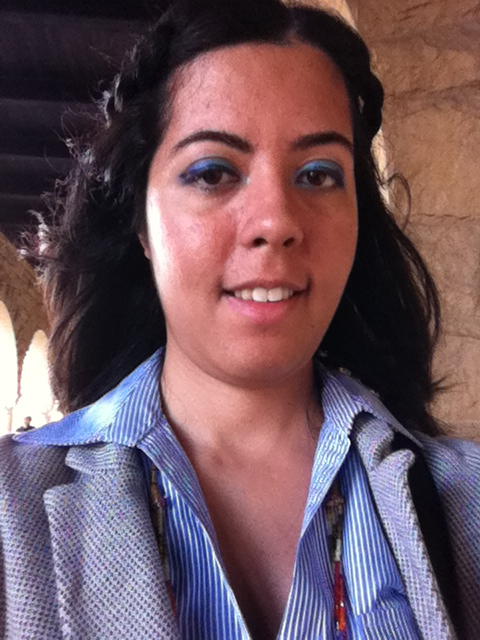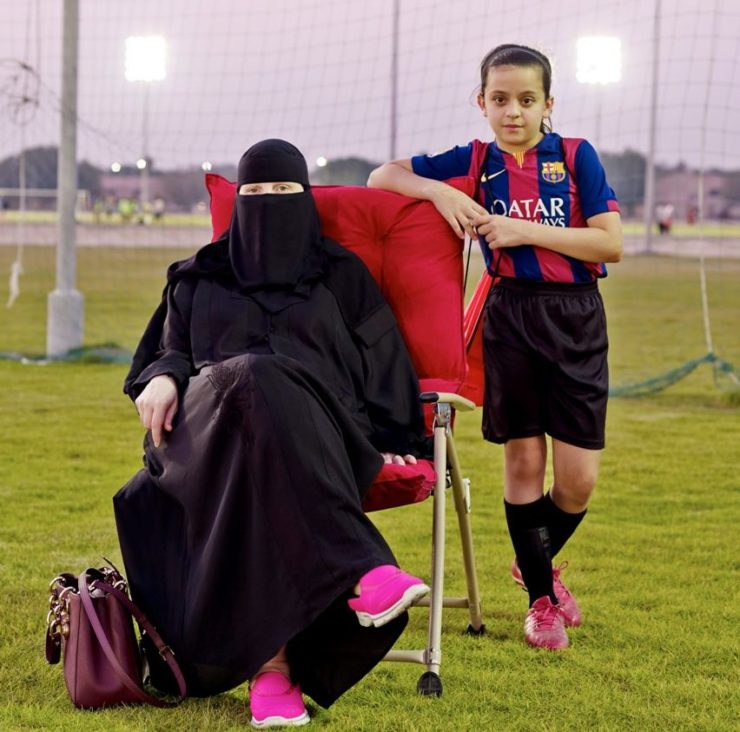
An image from "Aramco: Above the Oil Fields."
It isn’t often that you open a book and leap into your childhood. A wave of nostalgia washed over me as I flipped through New York-based photographer Ayesha Malik’s book, Aramco: Above the Oil Fields.
“We don’t stop to check the ordinary, which is why I do. We are so hyper-stimulated.”
Her Pakistani father was an expat working for the oil giant Saudi Aramco in Saudi Arabia and, like me, she was raised in the Kingdom. But unlike me, a Saudi national, she lived in a gated community in Dhahran, a manicured “Little America” with bilingual street signs and bumper stickers (in Arabic and English).
It was surprising to see a slice of my hometown, seldom seen from such an intimate yet detached perspective. It zoomed in on that particular bubble within Saudi Arabia often dismissed by outsiders (and even insiders), but it was also passive—in the sense that it was taken by someone observing without interacting. Although some images are directly communicating with the subjects, most are seen from the perspective of someone slightly in the background but who knows the grounds and its people on an intimate level. Much like Malik herself.
“Growing up, … I thought the States was this amazing place. I didn’t want to be in Aramco,” she says. “Now, it is surreal. Growing up, all of the houses were practical and the same. I liked to go to people’s houses and see what they had to make things a home. I’d go home and tell my mom, ‘Look what they did to make this look different.’ That was interesting to me.”
The pale pink cover of the book features images that, at first glance, seem so ordinary — nothing shouts Instagrammable there. But that is precisely the point: Malik aims to collect these moments and make them into a visual collage that weaves together all of these regular moments, the kind of moments that are so familiar to all of us but not often deemed compelling enough to be photographed, especially not in a coffee table book.
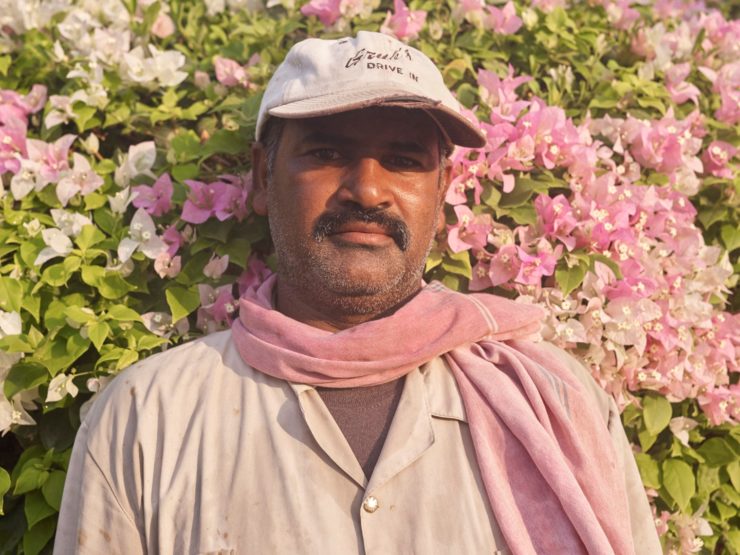
Many of the images in the Aramco book, set in Saudi Arabia, are tinged with pink.
“My cover is so regular. It feels nostalgic,” she says. “It is an ugly cover. It isn’t what you’d think of for a photobook, and that was deliberate. I know what I would have done to make it flashy and easy to digest. But the cover’s color was chosen because it is my view from rose-colored glasses. It’s a bit romantic.”
In fact, many of the places she photographed for the inside shots are also touched with a tinge of blush pink. I never noticed that Saudi has so much pink.
I met Malik recently on a cool evening in New York, and over steaming hot tea, and we reminisced about a simpler time, the kind conveyed in her book.
“The cover itself has a texture and it feels fuzzy so dust collects on it — you need to clean it off and protect it. It reminds me of the old felt books that you wrote your feelings in,” she told me.
“A lot of people say, ‘Why is she taking pictures of this—there’s nothing there.’ Some people look at a picture of something, it’s a constant peeling of abstract layers. … When I think of home, I smell construction paper, grass, glue and Clorox. I think of the school. I also think of the dry dust that goes into your nostrils and ears.”
The book is like a scrapbook, almost, sprinkled with professional snapshots, none containing captions or dates but with just enough context and visual clues to form our own stories. Who was this person — was it someone I passed on the street? The images could have been taken in the ’90s or last week. Some are so generic, so much like they were on the set of a movie yet to be made. I told Malik that we needed expats like her to take these ordinary moments, wrap them up and let us see them through fresh eyes.

The book captures everyday moments in Saudi Arabia's "Little America."
It was a happy coincidence that Malik and I both moved to New York City for graduate school. We had different upbringings: She was mostly in the confines of the Saudi Aramco compound, and I attended a Saudi school and commuted to the compound for recreational and educational purposes. We’ve both toggled between the two continents and had never met in the Kingdom but, funny enough, met in the Big Apple. We share a love for milk tea and an acute attention to detail.
When you meet Malik, she has a shy smile peering from beneath her long silky hair. But she also has this aura about her, where tranquility and gracefulness hover. Unlike many of my photographer friends, Malik doesn’t take out her camera or phone even once to capture any photos. She absorbs the space like a sponge and seems to tilt her head attentively and ponder the neglected corners in every room she enters.
The image of the Kingdom has shifted drastically inside and outside the country at such a rapid rate, we hardly recognize ourselves sometimes. That’s why Malik’s book is timely and more relevant than ever: We need stills like these to preserve those fleeting moments.
The book started as part of her school thesis project several years ago and evolved since. She’s gone back to Aramco seven or eight times to take photos, the latest photo trip in 2016.
With Saudi Arabia rapidly transforming into a modernized version of itself, Malik’s book serves as a sort of time capsule. She manages to preserve the snippets of childhood memory that most of us who’ve lived there over the last few decades can recall, but often don’t have tangible evidence of. She scanned receipts and school assignments, the kind of things most of us threw away, and tucked them into the pages. But most of the images are indoor and outdoor shots, with some portraits and some landscapes.
When I grew up in Dhahran, there were so many contradictions. It is conservative in parts and very open in others. Every time I would emerge back to “Saudi” after passing the checkpoint of the gated Saudi Aramco community, there seemed to be a lack of understanding of how people lived in the compound. There was a clear separation in Dhahran: inside Aramco and outside Aramco.
Many Aramcons have a keen sense of adventure and venture out into the rest of the city, but one could easily slide into the Aramco bubble and stay comfortably there without emerging into the rest of Saudi Arabia. With an expanding expat community, it has a grocery store called the commissary, a school, a hospital and even a small company movie theater. Women have been openly driving there for decades (without a license), and the rules of the abaya are less strict there. Men and women mingle much more freely, but an I.D. needs to be flashed at every checkpoint, so only those who work within the company or their listed guests can come in. Security is tight, and the sense of community is tighter.
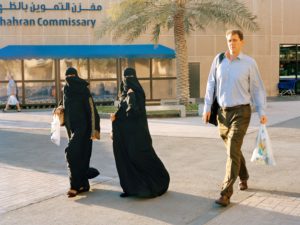
The Saudi city of Dhahran, where the Aramco compound is located, is a place of contradictions.
“Yes, it’s me in the photos, but it could be you,” she says. “It puts you in your own childhood. Most of us have a family photo like that. It feels very mundane and not ‘the moment’; it could be boring. But boring is very revealing, especially when it comes to photos. … We don’t stop to check the ordinary, which is why I do. We are so hyper-stimulated.”
Recently, the Kingdom has gone through a massive growth spurt; it was like it went from being a toddler to a teenager overnight. So many new changes have been happening for Saudi residents, including the news of allowing women to drive for the first time and opening up movie theaters in the Kingdom for the first time in decades. The image of the Kingdom has shifted drastically inside and outside the country at such a rapid rate, we hardly recognize ourselves sometimes. That’s why Malik’s book is timely and more relevant than ever: We need stills like these to preserve those fleeting moments.
“Lately, with everything that has been happening in Saudi and the world, the images here are sort of a relic,” she says. “People are going to laugh, but it has changed massively, not just the rules and regulations in Saudi, but also mind-sets.
“A lot of exciting things are happening. Some of the changes are concrete and some are superficial, like more of a public relations thing. Young Saudi artists are talking about their experiences using line, color and composition. Exploring feelings — and not everything comes about from struggling.”
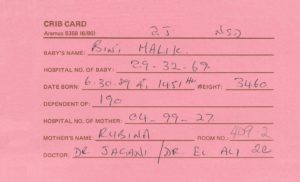 When I asked why she decided to scan simple, everyday things like newspaper clippings of movie times in a now-defunct television station, a receipt for a dry cleaning or proof of purchase for film developing, her answer was simple. “I felt like these are certain things that I can’t capture in a photo. It’s tactile in a form of memory that is psychological layer, even the words and fonts used or the handwriting.”
When I asked why she decided to scan simple, everyday things like newspaper clippings of movie times in a now-defunct television station, a receipt for a dry cleaning or proof of purchase for film developing, her answer was simple. “I felt like these are certain things that I can’t capture in a photo. It’s tactile in a form of memory that is psychological layer, even the words and fonts used or the handwriting.”
Malik warns me that not all the images should be analyzed or dissected. Some of it is just aesthetically-pleasing and some of it is just pretty. She recognizes that she has a very specific perspective to share, and some of it is very “Western.” But she makes it clear that she isn’t an ambassador to anyone or anything.
“People want me to have a clear message or intention; it’s not this one-track thing. There’s a million different ways to look at it. Some of my photos aren’t saying anything — they are mundane moments that feed off each other, repeats and gives an equal treatment of people. You can see this person as your mom.
“This project has a lot of white people in it. I’m brown, and half of my family is brown. You would be exhausted looking at this trying to explain every aspect of my identity.”


